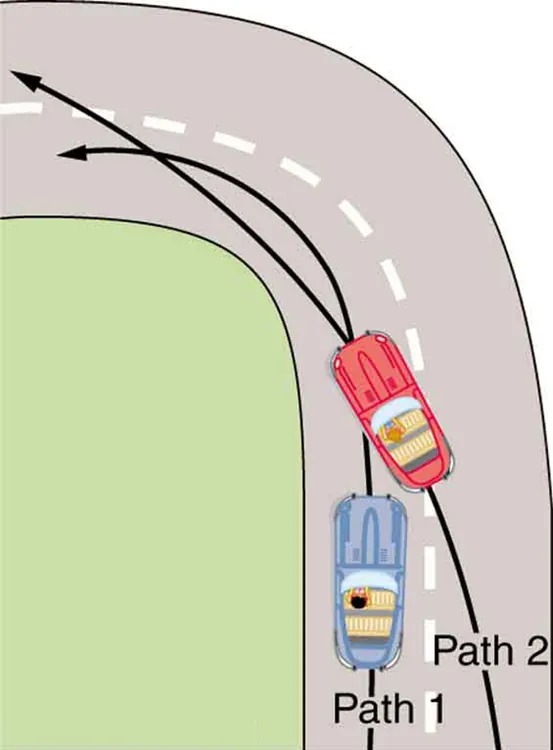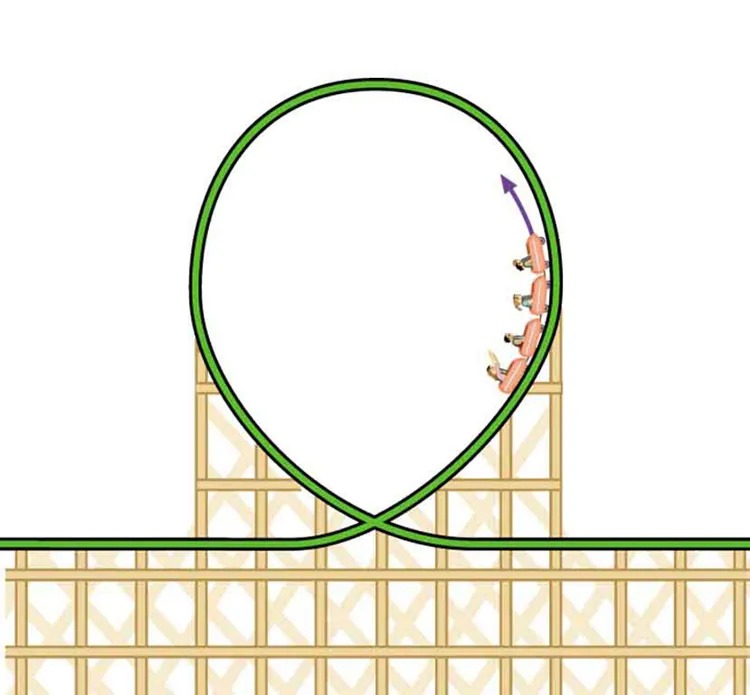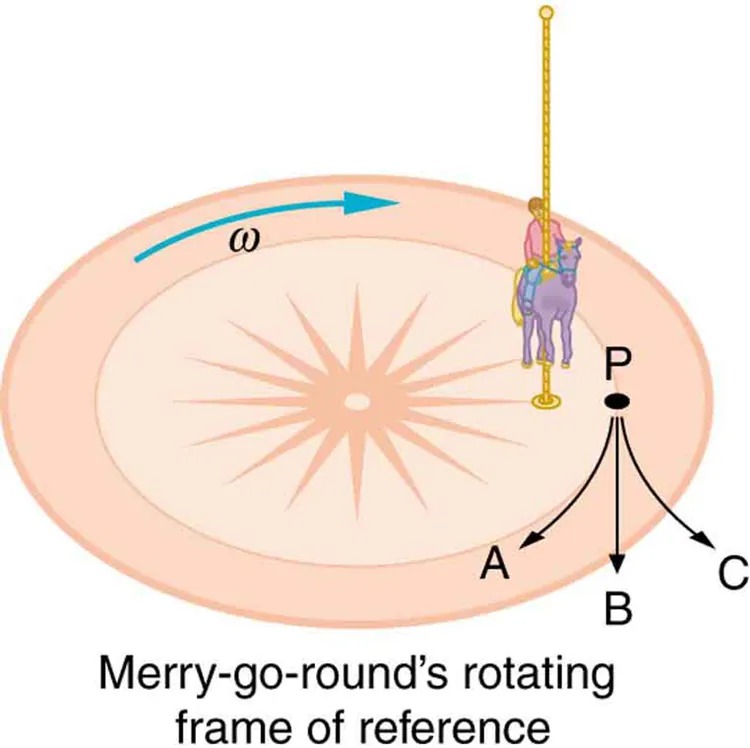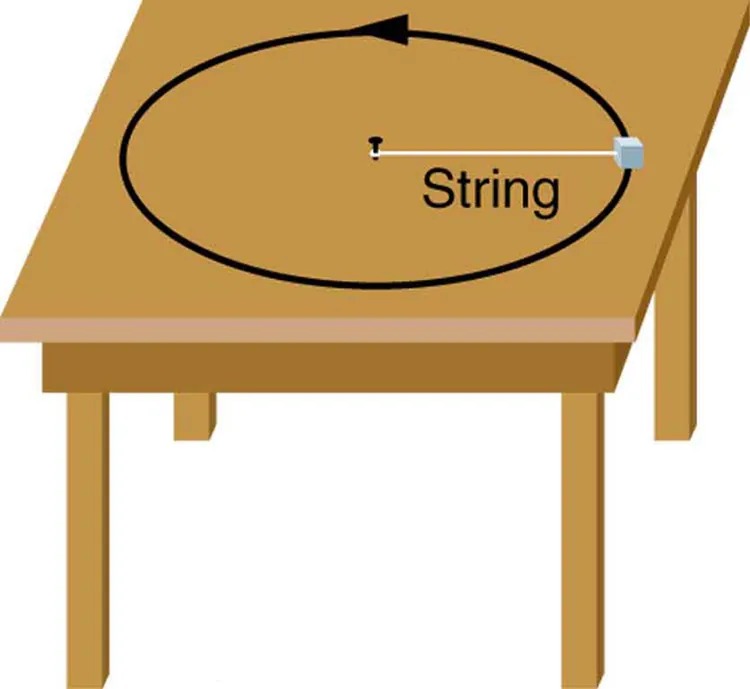Conceptual Questions
Conceptual Questions
5.1 Rotation Angle and Angular Velocity
- There is an analogy between rotational and linear physical quantities. What rotational quantities are analogous to distance and velocity?
5.2 Centripetal Acceleration
- Can centripetal acceleration change the speed of circular motion? Explain.
5.3 Centripetal Force
- If you wish to reduce the stress (which is related to centripetal force) on high-speed tires, would you use large- or small-diameter tires? Explain.
- Define centripetal force. Can any type of force (for example, tension, gravitational force, friction, and so on) be a centripetal force? Can any combination of forces be a centripetal force?
- If centripetal force is directed toward the center, why do you feel that you are ‘thrown’ away from the center as a car goes around a curve? Explain.
- Race car drivers routinely cut corners as shown in Figure 5.22. Explain how this allows the curve to be taken at the greatest speed.

Figure 5.22 Two paths around a race track curve are shown. Race car drivers will take the inside path (called cutting the corner) whenever possible because it allows them to take the curve at the highest speed. Image from OpenStax College Physics 2e, CC-BY 4.0
Image Description
The image depicts a curved road with two cars and two possible driving paths.
– Road Details: The road bends to the left with a grassy area on the inner side.
– Cars:
– There is a red car positioned on the outer side of the curve.
– A blue car is positioned behind the red car and closer to the grass.
– Paths:
– Path 1: Indicated as a solid line, it starts from the position of the blue car and follows a tighter curve close to the inner grassy edge.
– Path 2: Indicated as the path followed by the red car, depicted with a wider line that moves further from the grassy edge, taking a wider arc around the bend.
The image illustrates different trajectories a vehicle can take while navigating a curve.
- A number of amusement parks have rides that make vertical loops like the one shown in Figure 5.23. For safety, the cars are attached to the rails in such a way that they cannot fall off. If the car goes over the top at just the right speed, gravity alone will supply the centripetal force. What other force acts and what is its direction if:(a) The car goes over the top at faster than this speed?(b)The car goes over the top at slower than this speed?

Figure 5.23 Amusement rides with a vertical loop are an example of a form of curved motion. Image from OpenStax College Physics 2e, CC-BY 4.0
Image Description
The image shows a diagram of a roller coaster loop. The track is depicted in green and forms a vertical loop, similar in shape to an inverted tear drop. The roller coaster cars, illustrated with three cars in sequence, are positioned on the right side of the loop, ascending upward in a clockwise direction. There is a purple arrow pointing upwards, indicating the direction of movement. The structure supporting the track is wooden and crisscrossed, resembling a classic wooden roller coaster design. The background is plain white, highlighting the roller coaster structure.
- What is the direction of the force exerted by the car on the passenger as the car goes over the top of the amusement ride pictured in Figure 6.30 under the following circumstances:
(a) The car goes over the top at such a speed that the gravitational force is the only force acting?
(b) The car goes over the top faster than this speed?
(c) The car goes over the top slower than this speed? - As a skater forms a circle, what force is responsible for making her turn? Use a free body diagram in your answer.
- Suppose a child is riding on a merry-go-round at a distance about halfway between its center and edge. She has a lunch box resting on wax paper, so that there is very little friction between it and the merry-go-round. Which path shown in Figure 5.24 will the lunch box take when she lets go? The lunch box leaves a trail in the dust on the merry-go-round. Is that trail straight, curved to the left, or curved to the right? Explain your answer.

Figure 5.24 A child riding on a merry-go-round releases her lunch box at point P. This is a view from above the clockwise rotation. Assuming it slides with negligible friction, will it follow path A, B, or C, as viewed from Earth’s frame of reference? What will be the shape of the path it leaves in the dust on the merry-go-round? Image from OpenStax College Physics 2e, CC-BY 4.0
Image Description
This image illustrates a merry-go-round from a top-down perspective, focusing on the concept of a rotating frame of reference. The merry-go-round is depicted as a circular platform with an outer rim. There is a stylized star pattern in the center of the platform. On the right side, a horse with a rider is fixed to a vertical pole on the edge of the platform.
An arrow labeled with the Greek letter “ω” (omega) indicates the direction of rotation, going clockwise. Below the merry-go-round, there are labeled points with arrows emanating from point “P”, directed towards “A”, “B”, and “C”, representing vectors.
The text at the bottom of the image reads “Merry-go-round’s rotating frame of reference.”
- Do you feel yourself thrown to either side when you negotiate a curve that is ideally banked for your car’s speed? What is the direction of the force exerted on you by the car seat?
- Suppose a mass is moving in a circular path on a frictionless table as shown in figure. In the Earth’s frame of reference, there is no centrifugal force pulling the mass away from the centre of rotation, yet there is a very real force stretching the string attaching the mass to the nail. Using concepts related to centripetal force and Newton’s third law, explain what force stretches the string, identifying its physical origin.

Figure 5.25 A mass attached to a nail on a frictionless table moves in a circular path. The force stretching the string is real and not fictional. What is the physical origin of the force on the string? Image from OpenStax College Physics 2e, CC-BY 4.0
Image Description
The image is a diagram showing a top view of a wooden table with a physics experiment setup. A circular track is drawn on the table, represented by a thick black line. At the center of this circle, a small pin is inserted into the table. A string is attached to the pin and extends to the edge of the circle, where it is connected to a small blue block. The string runs parallel to one side of the table and appears to allow the block to move in a circular path around the pin. An arrow drawn along the circumference of the circle indicates the direction of motion. The word “String” is labeled on the string itself, suggesting the experimental setup involves circular motion.
5.4 Newton’s Universal Law of Gravitation
- Action at a distance, such as is the case for gravity, was once thought to be illogical and therefore untrue. What is the ultimate determinant of the truth in physics, and why was this action ultimately accepted?
- Two friends are having a conversation. Anna says a satellite in orbit is in freefall because the satellite keeps falling toward Earth. Tom says a satellite in orbit is not in freefall because the acceleration due to gravity is not [latex]9.80 m /\text{s}^{2}[/latex]. Who do you agree with and why?
- Draw a free body diagram for a satellite in an elliptical orbit showing why its speed increases as it approaches its parent body and decreases as it moves away.
- Newton’s laws of motion and gravity were among the first to convincingly demonstrate the underlying simplicity and unity in nature. Many other examples have since been discovered, and we now expect to find such underlying order in complex situations. Is there proof that such order will always be found in new explorations?

